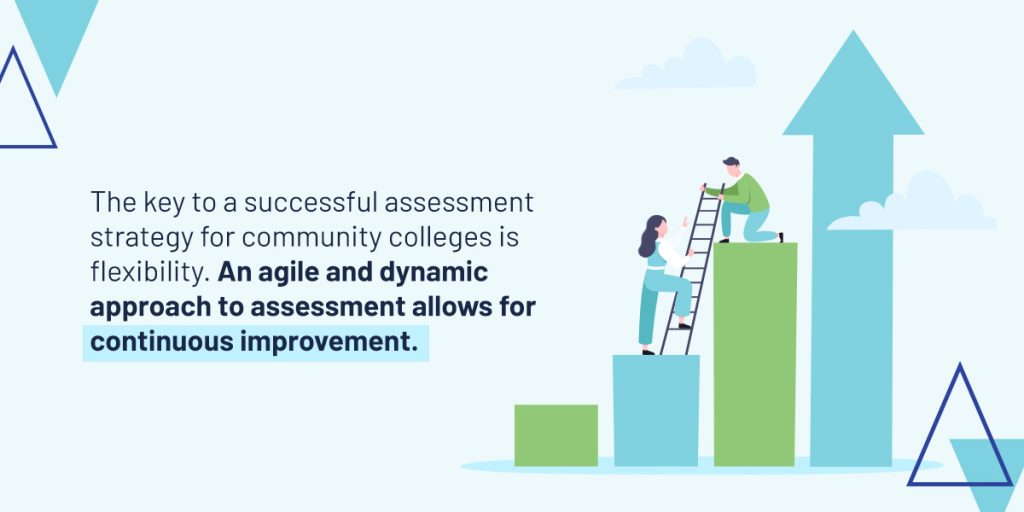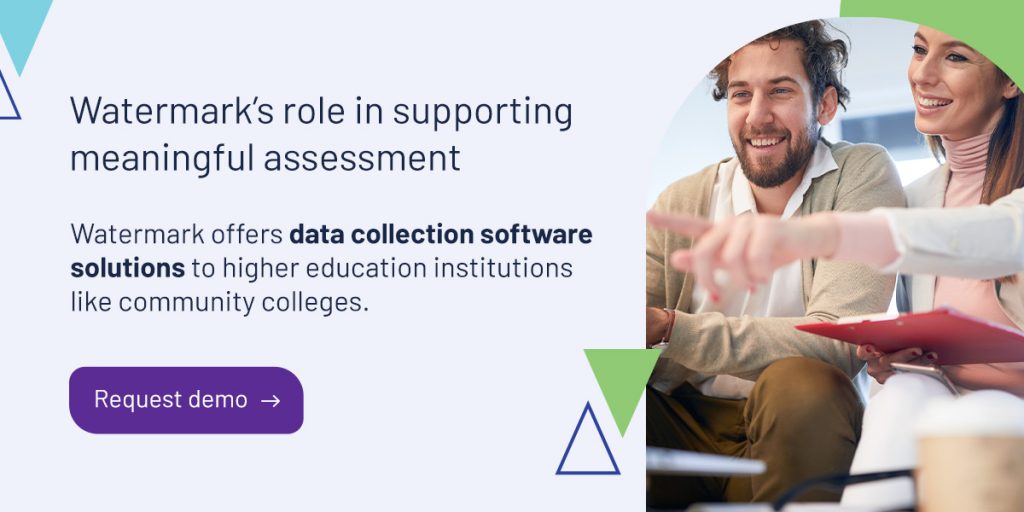




Community colleges face several unique assessment challenges. In recent years, it has become increasingly clear that these institutions play an invaluable role in higher education, and in society at large. However, they’re under considerable pressure to link student outcomes to workplace skills, meet enrollment goals, and retain students who face their own personal challenges.
A fresh perspective on assessment is essential for community colleges to produce strong learning outcomes and drive program completions. Watermark and the National Institute for Learning Outcomes Assessment (NILOA) coordinated a panel discussion that offered a look at how top leaders at several community colleges continually evolve their assessment processes. Consider these strategies for your institution.
Community colleges have more flexibility in how their general education classes are designed and also offer different educational paths, like certifications, workforce training, and associate degrees. This variety makes assessment more complicated. “We have about 39 transfer programs that run the gamut — industrial, medical, and culinary arts. Finding ways to assess those programs, which have a lot of high-contact hours, can be challenging,” says Jill Millard, Associate Vice President of Planning and Institutional Effectiveness at South Piedmont Community College.
Smaller class sizes can also pose a planning issue. “We cannot assess on a yearly basis because we might only have four or five graduates in any given program, so it puts a new spin on assessment and makes us really think about how we can assess our programs and our student progress,” states Kathy Adair, Director of Development & Assessment and Social Science Department Chair at Bay Mills Community College.
Many educators at community colleges are adjunct faculty teaching as a second job, so they have less time for administrative tasks like creating in-depth assessment plans. To simplify the concept of assessment, it’s helpful to tie it back to their other job.
“One way I like to connect with adjuncts is to remind them that they’ve been assessing at their workplace already — they just didn’t call it that. So if you were evaluating employees, what does the occupation require? You can connect that to the program, and then kind of teach them the concept of assessment from there,” Millard states.
Jacob Ashby, Assistant Dean for Assessment and Articulation at Frederick Community College, suggests the following resources to help support adjunct faculty:
Community colleges have unique challenges when it comes to assessment, from efficiently gathering information from adjunct faculty to managing assessment strategy and reporting for nontraditional programs.
Adding to the complexity, community colleges and associate degree-granting institutions are more likely than all other schools to use placement exams, employer feedback, and local surveys. When schools use assessment results for external accountability and external funding, the pressure increases. Some of the most prevalent assessment challenges at community colleges include:
These challenges are often interconnected, creating a complex web of issues that your community college must navigate to improve student learning outcomes. Addressing these challenges with a systematic approach to assessment planning can go a long way in creating a positive assessment landscape. Focus on flexible and adaptive assessment strategies that leverage continuous evaluation and adjustment to ensure a streamlined and representative assessment process.

Because each student enrolls with a different goal in mind, the key to a successful assessment strategy for community colleges is flexibility. An agile and dynamic approach to assessment allows for continuous improvement. You can adapt courses, general education, and program assessment to align with changing student expectations and how students move through the curriculum.
Here’s how to make it happen:
Assessment data collection should be focused on continuous improvement, with student learning and engagement at the center of it all. Set specific goals around improvement and work backward to define how those goals will be met. Only collect data that ties back to these goals, and know what you will do with the numbers once you have them. This ensures that the time and energy spent on assessment is truly valuable, which makes it easier to get faculty on board.
It’s often difficult to keep adjunct faculty engaged in the assessment process, particularly when they’re working a full-time job in addition to their teaching load. However, private industry faculty are already familiar with the concept of assessment in their other job — if they’re evaluating employees and providing feedback on their performance, that’s assessment. Encourage them to ask, “What does the job require?” and “What defines a good employee?” By connecting these ideas back to the program, they can more easily define learning outcomes.
Curriculum mapping is another essential tool in aligning course content with student learning outcomes. With an effective curriculum map, you can create student roadmaps to success beyond community college, planning an effective sequence for instruction that directly connects courses in the real world. When you map outcomes to courses, you can define how to assess student progress on the way.
When you start to design an assessment, start with what you’re already measuring and identify any gaps that need to be filled in. Then, adjust the measurement process or add new questions to capture any missing details. For example, you can use the indirect measures you’re gathering in regular course evaluations and general surveys to uncover students’ perceptions of their performance or program efficacy. However, you may need to add new survey questions to gather more insights into a specific learning outcome.
You’re likely already collecting data in a variety of systems but are left with a broad range of information about how students are performing and how they feel about the coursework. By using integrated assessment and course evaluation solutions, you can take advantage of automated workflows that keep the process moving and access unified reports that bring both types of measurement together.
Higher ed is continuously changing, and many community colleges are seeing increased enrollment as a result. Now is the time to review your assessment strategy to make sure it’s keeping pace.
Because community college assessment is so unique compared to other higher education institutions, implementing the right strategies can help you overcome challenges before they occur. When you can make the most of your college assessment, you can better serve your student body and implement significant improvements across campus that help you attract and maintain students. Some ways to overcome assessment challenges include:
Having strong and effective assessment services and systems can reduce challenges for community colleges. When your assessment processes are essential for determining your school’s performance and improvement initiatives, you can make more of your efforts by understanding the challenges community colleges face and trying to avoid them.
All of the panelists agreed that technology plays an essential role in supporting meaningful assessment at their institutions.
“The Higher Learning Commission (HLC) was pretty impressed with the role of technology and the reports that we’re able to present to them for continuous improvement within our courses and our programs. It’s just been great, and I don’t want to go back to binders,” said Adair.
When searching for the right technology to support the assessment process, Watermark offers data collection software solutions to higher education institutions like community colleges. Because we understand the unique needs community colleges face annually, we design our solutions with features targeted to higher ed institutions and their desired outcomes. Our assessments projects solution uses a rubric-based system to help colleges organize their assessments and better understand your data.
To learn more about how to improve assessment processes at your community college, watch the Assessment success strategies for community colleges panel discussion. Request a demo today to get started on effectively measuring your assessment data.






























































































































































































































































































































































































